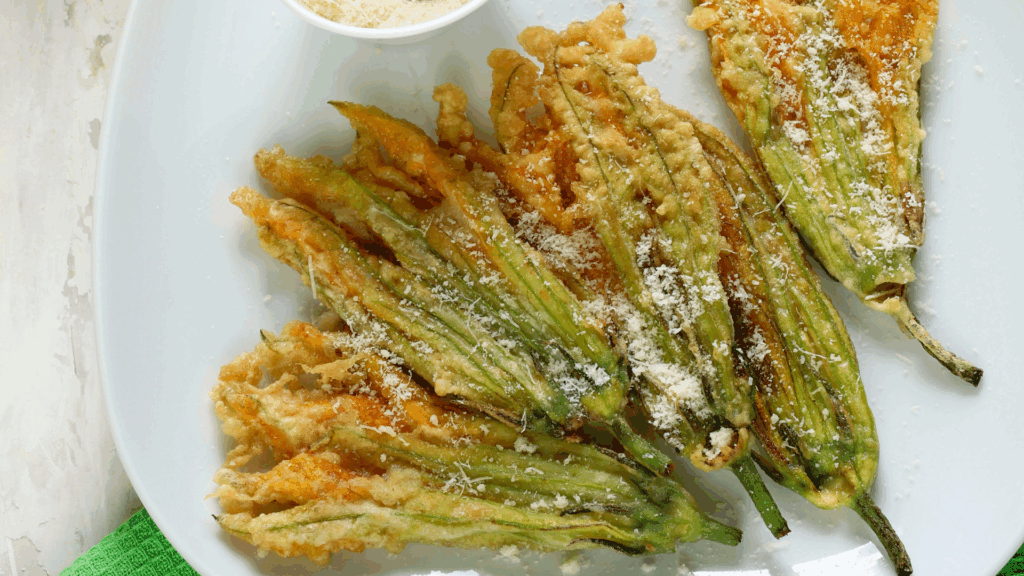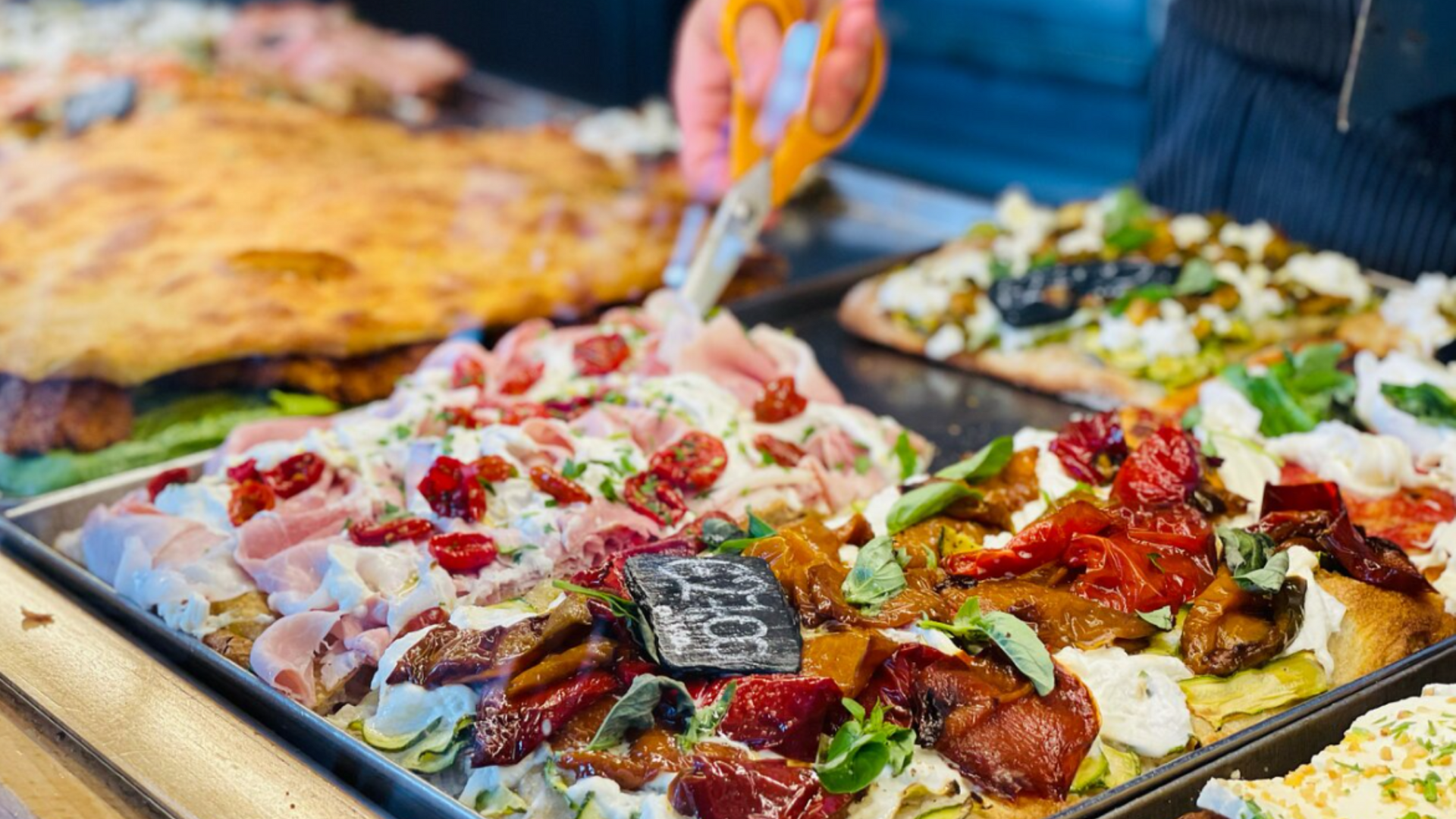What Comes to Mind When You Think of Roman Food?
While Carbonara is often the first dish people think of, there’s an entire whole world of Roman dishes that go above and beyond one plate of pasta.
And let’s face it — Carbonara is overrated.
During my time working as an au pair in Rome, I fell in love with lesser-known Roman dishes. They genuinely capture the city’s rich culinary heritage. From indulgent coda alla vaccinara to crispy baccalà fritto, these dishes deliver an authentic taste of Rome.
If you’re ready to embark on a culinary adventure, you eat as the Romans do. Here are ten must-try Roman dishes that outshine Carbonara.
Table of Contents
- 1. Pasta all’Amatriciana
- 2. Porchetta di Ariccia
- 3. Saltimbocca alla Romana
- 4. Coda alla Vaccinara
- 5. Pollo alla Romana
- 6. Pizza a Taglio
- 7. Carciofi alla Giudia (Jewish-Style Artichokes)
- 8. Baccalà Fritto (Salted Fried Cod)
- 9. Supplí
- 10. Fiori di Zucca Fritti (Fried Zucchini Blossoms)
- Honorable Mentions and Where to Find Them in Rome
1. Pasta all’Amatriciana

Understanding Roman Pasta Dishes
Carabonara shares two staple ingredients with three other classic Roman specialties. These famous dishes are Cacio e Pepe, Gricia, and Amatriciana.
Cacio e Pepe, the simplest of the four, incorporates only black pepper and Pecorino Romano—the perfect base. Adding some salty guanciale, or cured pork jowl, transforms the dish into Gricia. Once an egg is added to the sauce, it becomes pasta Carbonara.
But that is not our concern today.
What is Pasta all’Amatriciana?
When you substitute the egg for tomato, pasta all’Amatriciana is born.
Ripe plum tomatoes, freshly cracked pepper, sharp pecorino, and salty guanciale—what’s not to love? Amatriciana is my favorite Roman pasta. I recommend pairing it with rigatoni or bucatini pasta, as they capture all the flavorful sauce!
Where to Eat Pasta All’Amatriciana in Rome
Roscioli Salumeria con Cucina, Campo de’ Fiori — Roscioli has many different departments that offer a wide range of foods. They make everything from pizza to desserts. Additionally, Roscioli serves up delicious Roman classics like pasta all’Amatriciana in their salumeria, ensuring an authentic and satisfying dining experience.
Trattoria Da Enzo al 29, Trastevere — This dreamy little trattoria steals the hearts of Romans and captivates tourists. The team offers quick and friendly service. They are known for serving authentic specialties, such as Rome’s famous pasta.
Vecchia Roma, Vittorio Emanuele — Simply walking through Vecchia Roma’s door instantly transports you to old-world Rome. The food is genuinely Roman, with incredible classic pasta like all’Amatriciana.
2. Porchetta di Ariccia

What is Porchetta di Ariccia?
Porchetta di Ariccia dates back to ancient Roman cuisine and originates from the Castelli Romani, a suburb just outside Rome.
Traditionally, pork is stuffed with rosemary, folded like a jelly roll, and roasted until deliciously fragrant. Herbaceous and fork-tender, I can confidently say that porchetta is one of the best foods I have ever eaten.
I love eating porchetta di Ariccia with some tangy mustard and cicoria rippasata, or sauteed chicory, as a side dish.
Where to Eat Porchetta di Ariccia in Rome
Ai Tre Scalini, Monti — This long-stranding spot is my favorite for porchetta in the city. When I lived in Rome, I went so often ththat e host knew my name. The establishment opened in 1895 and features an extensive wine list (try the pecorino—the wine, not the cheese!).
L’Antico Forno Roscioli, Campo de’ Fiori — This famous Roman spot deserves another mention. Roscioli makes everything excellent. Its porchetta di Ariccia is particularly outstanding.
Fa.Lu.Cioli, Castel Gandolfo — For authentic porchetta, you’ll have to leave Rome and head to the Castelli Romani. Fa.Lu.Cioli is a renowned porchetta manufacturer in the area, with a shop in Castel Gandolfo.
You can take a day trip to the village and enjoy a porchetta sandwich beside Lake Albano. However, if you’re strapped for time in Rome, you can also visit their location near the Colosseum, Cioli 1917.
3. Saltimbocca alla Romana

What is Saltimbocca alla Romana?
Saltimbocca, literally meaning ‘to jump in the mouth,’ has its roots in Rome. Today, there are several variations of saltimbocca, but the classic Roman dish typically features veal, sage, and prosciutto.
After being wrapped in ham and sage, the veal soaks in wine and butter. This rich combination allows for a flavorsome bite every time.
Where to Eat Saltimbocca alla Romana in Rome
Ristorante Arlù, Prati — Just outside Vatican City, Ristorante Arlù takes traditional Roman fare and adds a modern twist. They do a renowned take on Saltimbocca alla Romana.
Cipasso, Historical Center — This critically acclaimed restaurant received a 2024 Traveler’s Choice Award on TripAdvisor. It is also featured in the Michelin Guide. They use seasonal ingredients to guarantee the freshest, highest-quality dishes possible.
Tonnarello, Trastevere — Tonnarello has been a local favorite since 1876. It serves authentic Roman dishes to thousands of diners every year. Guests describe its saltimbocca as some of the best they’ve ever had.
4. Coda alla Vaccinara

Understanding Rome’s Offal Offerings
For centuries, poor Romans had to make do with cheap ingredients like offal. These animal ‘variety parts’ would usually go unconsumed by Rome’s elite.
Offal is also known as quinto quarto, meaning ‘fifth quarter.’ This term refers to the historical division of cattle in Rome, where the best cuts of meat were reserved for the elite and highest classes.
The peasants, however, were given the lowest-quality meat. Despite this, they managed to transform these less desirable cuts into delicious and valuable dishes.
The hip, food-centric Testaccio neighborhood has many restaurants serving offal specialties. Testaccio was home to the largest slaughterhouse in Europe, which ceased operations in 1975.
What is Coda alla Vaccinara?
Just south of Testaccio in Rome’s Regola quarter, i vaccinari, or butchers, received compensation with quinto quarto. These meats ranged from organs to tails.
Enter coda alla vaccinara.
Tender oxtail takes center stage, slow-cooked alongside celery in a fragrant tomato sauce. Hearty and warming, this classic Roman dish helps the city get through chilly winters. Paired with creamy polenta, coda alla vaccinara is ideal for cold nights.
Coda alla vaccinara seems adventurous, but it’s less intimidating than it sounds.
These Regola butchers helped turn oxtail from a throwaway meat into a delicacy. Today, oxtail is expensive and highly coveted – oh, how the tables turn!
Where to Eat Coda alla Vaccinara in Rome
Checchino dal 1887, Testaccio — Checchino has been a local favorite for nearly 140 years. The restaurant serves comforting dishes made with quinto quarto.
Agustarello a Testaccio, Testaccio — Since 1957, this hidden gem has pleased locals and visitors who wander through the door. The cozy ambiance, simple decor, and inconspicuous location are signs that the food will be as authentic as it gets.
Nerone, Esquilino — Nerone is easily accessible from Rome’s central train station, Termini. Nerone offers good value Roman cuisine and live music on some evenings.
5. Pollo alla Romana

What is Pollo Alla Romana?
Found in most trattorias in Rome, Roman-style chicken is a delightful yet simple dish. Chicken is first seared and then braised gradually with sweet peppers and tomatoes, creating a decadent and flavorful stew.
It is another dish that stems from impoverished Romans using low-quality meat, along with cheap wine and herbs.
Considered a summer dish, Romans typically enjoy pollo alla Romana at room temperature on warm nights. Before Italians go on August break, or Ferragosto, they celebrate with a big plate of this Roman-style chicken.
Where to Eat Pollo alla Romana in Rome
Piatto Romano, Testaccio — Popular among Italians, their menu consists of both classic Roman fare and innovative meat dishes. It is the perfect spot for a leisurely dinner on a summer evening.
Trattoria Pennestri, Piramide — Don’t be surprised if it’s hard to find a seat for dinner at this humble restaurant. With a modern take on classic Roman dishes, a visit here is worth venturing out of the city center.
Nannarella, Trastevere — Nannarella is Tonnarello’s sister restaurant. Located in Piazza San Callisto, a popular hangout spot, Nannarella has sidewalk seating in an eclectic Roman setting. The pollo alla Romana provides a delicious and flavorful experience with every bite.
6. Pizza a Taglio

What is Pizza a Taglio?
Pizza a taglio is Rome’s version of thin-crust pizza, typically served in rectangular slices. Usually cut into slices, a taglio pizza makes for the perfect on-the-go meal.
Pizzerias offer a wide variety of toppings, from smoked salmon with cream cheese to potato slices (this is extremely popular!). There are no limits – unless you ask for pineapple on top.
I definitely recommend trying tiny slivers of each so you can sample all the pizza toppings!
Where to Eat Pizza a Taglio in Rome
La Renella, Trastevere — La Renella holds a special place in my heart. The flavors change often, so there’s a new pizza to try every day. They offer a unique variety of pizza toppings that you won’t find in other Roman pizzerias.
Alice, Various locations — Alice is a popular chain, serving a fun array of pizzas a taglio. The options include Cacio e Pepe, spicy Arrabbiata, and even Nutella! You’ll find them in Rome’s busiest areas, from Trastevere to San Lorenzo. I’ve included a few locations on the map.
Forno Campo de’ Fiori, Campo de’ Fiori — This bakery specializes in freshly baked bread and pastries. Their focaccia serves as the perfect base for pizza a taglio.
7. Carciofi alla Giudia (Jewish-Style Artichokes)

What is Carciofi alla Giudia?
Just thinking about these Jewish-style artichokes makes my mouth water. Fried to crispy perfection and generously salted, they can be eaten whole, from the crunchy leaves to the tender stems.
Carciofi alla giudia remain a staple of Rome’s Jewish Quarter. Throughout the neighborhood, the comforting smell of deep-fried food entices you to indulge in the salty snack.
From the 16th to 19th century, Roman Jews were exposed to harsh rules not enforced on Rome’s general public. Almost 4,000 Jews were confined within ghetto walls, separated from the rest of society.
Yet, this allowed the ghetto’s inhabitants to develop a hybrid cuisine, intertwining kosher practices with Roman classics. Carciofi alla giudia represent the resilience of Rome’s once-marginalized Jewish community.
Where to Eat Carciofi alla Guidia in Rome
Nonna Betta, Jewish Quarter — They serve some of the most flavorful Jewish-style artichokes I’ve ever had. I make it a point to visit whenever I return to Rome. After taking one bite of the indulgent snack, you’ll be ordering three more.
La Taverna del Ghetto, Jewish Quarter — This place is known for its excellent quality artichokes and also offers traditional dishes synonymous with Rome’s Jewish Quarter.
Da Giggetto, Jewish Quarter — Roman Jewish heritage and an ancient ambiance set Giggetto apart from other restaurants within the neighborhood. As you overlook the ruins of Portico d’Ottavia, you feel the spirit of ancient Rome while indulging in wonderfully crunchy fried artichokes.
8. Baccalà Fritto (Salted Fried Cod)

What is Baccalà Fritto?
The salty snack’s full name is baccalà fritto alla giudia, meaning ‘fried Jewish style.’
Sound familiar?
Like carciofi alla giudia, this fried cod has its roots in Rome’s Jewish Quarter. Salted cod was a staple in Roman Jewish households due to its long shelf life and versatility.
However, baccalà has transcended religious boundaries for centuries and is also a favorite among Catholics. On Christmas Eve, you’ll find baccalà fritto on tables across Italy.
Baccalà fritto, with its flaky interior and crispy exterior, will remain a cherished Roman specialty for years to come.
Where to Eat Baccalà Fritto in Rome
Dar Filettaro a Santa Barbara, Campo de’ Fiori — Dar Filettaro a Santa Barbara specializes in one dish, and they do it well. Since 1890, diners have flocked to this tiny establishment for their baccalá fritto, said to be the best in Rome.
Osteria Pesce Fritto e Baccalà, San Lorenzo — Located in the vibrant neighborhood of San Lorenzo, this Osteria serves modern, inventive dishes alongside Roman classics, including baccalà fritto.
Pizzeria Ai Marmi, Trastevere — One of the specialties at Pizzeria Ai Marmi is delicious baccalà fritto. Other notable offerings include pizza and supplì.
9. Supplí

What is Supplì?
Most want to refer to this snack as arancini, but that’s a mistake! For starters, arancini come from Sicily, while supplì call Rome home. Similar to a French croquette, supplì was first introduced to the Romans by Napoleon’s army in the 1800s.
Arancini are a stuffed rice ball with meat sauce. Supplì has a simple mozzarella and tomato sauce filling. However, fillings vary.
Also referred to as supplì al telefono because when pulled, the mozzarella’s long strands resemble telephone cords.
When strolling through the bustling streets of Rome, you’ll find plenty of restaurants serving supplì. The cheesy specialty pairs well with a bitter Aperol Spritz during aperitivo, when Italians enjoy a pre-dinner drink and snack.
Where to Eat Supplì in Rome
Supplì, Trastevere — As their name implies, they specialize in tasty Roman street food. With no seating, they make a variety of supplì perfect for a snack on the go.
Pizzarium Bonci, Trionfale — Though they primarily famous for its creative pizza menu, Pizzarium Bonci also offers great supplì, vetted by locals.
Supplizio, Regola — This little shop is steps away from the banks of the Tiber River. It serves Amatriciana and Cacio e Pepe-inspired supplì. You can also enjoy other classic Roman street food here.
10. Fiori di Zucca Fritti (Fried Zucchini Blossoms)

What is Fiori di Zucca Fritti?
It is safe to say Romans love their fried food. Zucchini blossoms bloom in late spring to early summer. With such a limited season, restaurants around Rome must act quickly. They harvest, stuff, and fry tons of fiori di zucca for hungry customers every year.
Filled with creamy mozzarella and salty anchovies, fried zucchini blossoms are often described as incredibly addictive.
If you visit Rome when these specialties are in season, you’ll eat them during aperitivo alongside supplì.
Where to Eat Fiori di Zucca Fritti in Rome
Da Giggetto, Jewish Quarter — With a second mention, they’re doing fried zucchini blossoms as delicious as their fried artichokes.
Emma, Campo de’ Fiori — This modern space is well-known for its fried zucchini blossoms. It also serves a wide array of pizzas, Roman street food, and traditional pastas.
Da Gino alla Villetta, Trastevere — This tiny, tree-lined trattoria in Trastevere offers a unique and rustic dining experience. Here, you are guaranteed fantastic quality food at an excellent price.
Honorable Mentions and Where to Find Them in Rome
Abbacchio alla Scottadito

A tasty grilled lamb dish popular in the springtime, eaten by Romans during their Easter celebrations.
Unlike most Italian dishes, abbacchio alla scottadito is traditionally eaten by hand; scottadito means ‘burnt fingers.’
Trattoria da Teo serves quality abbacchio alla scottadito in Rome’s Trastevere neighborhood.
Straccetti di Manzo

Straccetti di Manzo is an obscure Roman dish with uncertain origins. Translating to ‘little rags of beef,’ this dish features paper-thin beef served on a bed of arugula with salty parmesan.
You can find straccetti di Manzo at Trattoria Da Luigi in the Historical Center.
Coratella con Carciofi

Though I haven’t eaten them myself, offal dishes are a quintessential part of Roman cuisine. They are said to be very flavorful and sustainable.
Another spring dish, coratella con carciofi includes lamb organs and artichokes cooked in a savory garlic, onion, and white wine sauce.
Head to Testaccio for the best offal dishes. One restaurant in the area to try is Trattoria Perilli.
Stracciatella alla Romana

I’m sure you have heard of Chinese egg drop soup, but did you know there’s an Italian version?
Stracciatella is a light and easy-to-prepare specialty that is perfect in a pinch. The recipe is simple: a mixture of egg, parmesan, salt, and pepper is dropped into a flavorful, simmering broth. The egg mixture creates stacce, or little curds.
In Rome, Trattoria da Augusto in Trastevere comes highly recommended.
Much More Than Carbonara
While Carbonara is undoubtedly a beloved dish, it’s just one of many incredible classics that showcase the richness of Rome’s culinary scene.
A visit to the eternal city reveals many more Roman dishes to discover and indulge in. Every neighborhood offers its unique specialties, from the Jewish Quarter to Regola, home to coda alla vaccinara.
Roman dishes tell the story of an eternal city filled with the most passionate people on earth. They exemplify the city’s heritage and extensive history. Constantly evolving, many of the foods eaten in Rome today may go as far back as ancient times.
Whether you’re visiting Rome for the first or fifteenth time, be sure to explore the city’s culinary staples beyond Carbonara, including crispy baccalá frito and savory saltimbocca alla Romana.
Buon appetito!


Leave a Reply